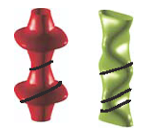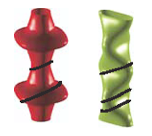Nesting questions
Despite intense study, researchers have not yet uncovered the secrets behind the peculiar properties of iron-based (pnictide) superconductors. Many theories that try to explain the driving mechanism of superconductivity in these materials suggest it is tied to so-called nesting of the electron and hole Fermi surfaces. This geometric feature of the Fermi surface, where one portion of the surface maps to another if it is translated by a suitable reciprocal-lattice vector, is common to the structure of many families of pnictides. Nesting often implies the existence of collective electron behavior, so if it is present in the host materials of the pnictides, it would have significant implications for their properties.
In a Rapid Communication appearing in Physical Review B, Brendan Arnold at the University of Bristol, UK, and colleagues use the de Haas-van Alphen effect, where electrons and holes orbit the extrema of the Fermi surface in response to a magnetic field, to map out the electron and hole Fermi surface sheets of , the parent material of an important family of pnictide materials. Besides providing highly detailed information about the geometry of the Fermi surfaces, they find, rather surprisingly, that the nesting present in the superconducting doped compounds persists in , which is not superconducting. This finding agrees with a growing list of experiments that conclude nesting does not play a dominant role in the development of superconductivity, at least in one family of pnictide compounds. – Alex Klironomos





